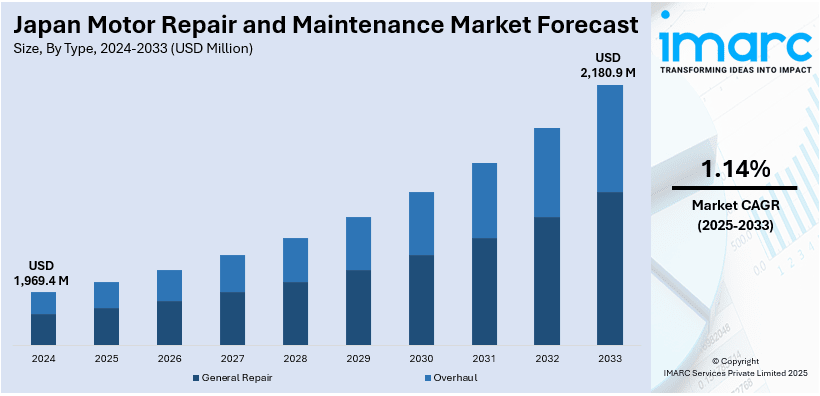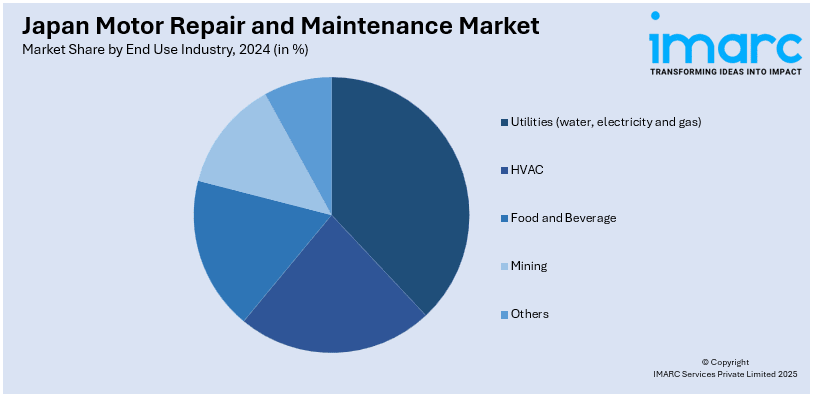
Japan Motor Repair and Maintenance Market Size, Share, Trends and Forecast by Type, Service, End Use Industry, and Region, 2025-2033
Japan Motor Repair and Maintenance Market Overview:
The Japan motor repair and maintenance market size reached USD 1,969.4 Million in 2024. Looking forward, IMARC Group expects the market to reach USD 2,180.9 Million by 2033, exhibiting a growth rate (CAGR) of 1.14% during 2025-2033. The market is driven by an aging vehicle fleet, rising consumer demand for vehicle longevity, growth in electric vehicle adoption, and increased road safety regulations. Expanding vehicle ownership and advancements in diagnostic technologies are also contributing to the demand for professional repair and maintenance services.
|
Report Attribute
|
Key Statistics
|
|---|---|
|
Base Year
|
2024 |
|
Forecast Years
|
2025-2033
|
|
Historical Years
|
2019-2024
|
| Market Size in 2024 | USD 1,969.4 Million |
| Market Forecast in 2033 | USD 2,180.9 Million |
| Market Growth Rate 2025-2033 | 1.14% |
Japan Motor Repair and Maintenance Market Trends:
Growth in Electric Vehicle (EV) Maintenance Services
As electric vehicle adoption accelerates in Japan, the motor repair and maintenance sector is undergoing a shift. For instance, as per industry reports, Japan’s electric vehicle market is expected to generate around ¥US$7.2 billion in revenue in 2025. EVs require specialized maintenance skills, diagnostic tools, and safety protocols, leading to increased investment in technician training and equipment upgrades. Traditional garages are adapting their service models to include high-voltage battery diagnostics, software updates, and electric drivetrain servicing. Additionally, the demand for predictive maintenance based on connected vehicle data is rising, helping owners reduce unplanned downtime. This trend is prompting industry players to collaborate with EV manufacturers to gain technical expertise and certification. The emergence of EV-only service centers is another sign of this transition, positioning Japan’s repair ecosystem for long-term alignment with national electrification goals and environmental sustainability targets.

Integration of Advanced Diagnostic and Telematics Tools
Technological integration is transforming motor repair operations across Japan. Repair centers are increasingly relying on advanced diagnostic software, telematics platforms, and AI-based systems to identify faults with greater precision and speed. These technologies enhance efficiency in both preventive and corrective maintenance by offering real-time data on engine performance, emissions, and component wear. Workshops are investing in cloud-based systems that centralize service history, maintenance schedules, and parts management. Moreover, the use of vehicle telematics enables remote diagnostics, allowing garages to prepare tools and parts in advance, minimizing repair times. The shift toward digital workflows is not only improving operational transparency but also aligning service providers with evolving consumer expectations for faster, data-driven service experiences. For instance, in August 2024, Asahi Kasei Engineering showcased its cloud-based V-MO predictive maintenance system for ocean vessel motors at SMM 2024 in Hamburg. V-MO, co-developed with Mitsui O.S.K. Lines (MOL), uses vibration sensor data and cloud analytics to monitor motor health and predict failures, allowing for repairs to be scheduled before port arrival, thus reducing vessel downtime.
Japan Motor Repair and Maintenance Market Segmentation:
IMARC Group provides an analysis of the key trends in each segment of the market, along with forecasts at the country and regional levels for 2025-2033. Our report has categorized the market based on type, service, and end use industry.
Type Insights:
- General Repair
-
- Bearing
- Stator
- Rotor
- Others
- Overhaul
The report has provided a detailed breakup and analysis of the market based on the type. This includes general repair (bearing, stator, rotor, and others) and overhaul.
Service Insights:
- On-site Service
- Off-site Service
A detailed breakup and analysis of the market based on the service have also been provided in the report. This includes on-site service and off-site service.
End Use Industry Insights:

- Utilities (water, electricity and gas)
- HVAC
- Food and Beverage
- Mining
- Others
A detailed breakup and analysis of the market based on the end use industry have also been provided in the report. This includes utilities (water, electricity and gas), HVAC, food and beverage, mining, and others.
Regional Insights:
- Kanto Region
- Kansai/Kinki Region
- Central/ Chubu Region
- Kyushu-Okinawa Region
- Tohoku Region
- Chugoku Region
- Hokkaido Region
- Shikoku Region
The report has also provided a comprehensive analysis of all the major regional markets, which include Kanto, Kansai/Kinki, Central/ Chubu, Kyushu-Okinawa, Tohoku, Chugoku, Hokkaido, and Shikoku Region.
Competitive Landscape:
The market research report has also provided a comprehensive analysis of the competitive landscape. Competitive analysis such as market structure, key player positioning, top winning strategies, competitive dashboard, and company evaluation quadrant has been covered in the report. Also, detailed profiles of all major companies have been provided.
Japan Motor Repair and Maintenance Market News:
- In April 2025, Sumitomo Corporation Japan sold its U.S.-based auto inspection and maintenance chain Midas to Mavis Tire Express Service. Midas is currently owned by TBC Corporation, a joint venture between Sumitomo and France’s Michelin. The sale is expected to conclude within the current quarter, generating over 20 billion yen (approximately USD 130 Million) for Sumitomo.
- In January 2024, KPIT Technologies enhanced its Trace2Fix vehicle diagnostics platform through a collaboration with Microsoft Azure OpenAI Service. Announced on January 8, 2024, the upgraded platform features a Copilot powered by large language models, voice commands, and natural language processing to support technicians in efficient fault diagnosis and repair. By combining KPIT’s diagnostics expertise with advanced data synthesis, vehicle context, and knowledge graphs, the solution aims to cut down no-trouble-found cases, boost first-time repair accuracy, and mitigate the skilled labor shortage.
Japan Motor Repair and Maintenance Market Report Coverage:
| Report Features | Details |
|---|---|
| Base Year of the Analysis | 2024 |
| Historical Period | 2019-2024 |
| Forecast Period | 2025-2033 |
| Units | Million USD |
| Scope of the Report |
Exploration of Historical Trends and Market Outlook, Industry Catalysts and Challenges, Segment-Wise Historical and Future Market Assessment:
|
| Types Covered |
|
| Services Covered | On-Site Service, Off-Site Service |
| End Use Industries Covered | Utilities (Water, Electricity and Gas), HVAC, Food and Beverage, Mining, Others |
| Regions Covered | Kanto Region, Kansai/Kinki Region, Central/Chubu Region, Kyushu-Okinawa Region, Tohoku Region, Chugoku Region, Hokkaido Region, Shikoku Region |
| Customization Scope | 10% Free Customization |
| Post-Sale Analyst Support | 10-12 Weeks |
| Delivery Format | PDF and Excel through Email (We can also provide the editable version of the report in PPT/Word format on special request) |
Key Questions Answered in This Report:
- How has the Japan motor repair and maintenance market performed so far and how will it perform in the coming years?
- What is the breakup of the Japan motor repair and maintenance market on the basis of type?
- What is the breakup of the Japan motor repair and maintenance market on the basis of service?
- What is the breakup of the Japan motor repair and maintenance market on the basis of end use industry?
- What are the various stages in the value chain of the Japan motor repair and maintenance market?
- What are the key driving factors and challenges in the Japan motor repair and maintenance market?
- What is the structure of the Japan motor repair and maintenance market and who are the key players?
- What is the degree of competition in the Japan motor repair and maintenance market?
Key Benefits for Stakeholders:
- IMARC’s industry report offers a comprehensive quantitative analysis of various market segments, historical and current market trends, market forecasts, and dynamics of the Japan motor repair and maintenance market from 2019-2033.
- The research report provides the latest information on the market drivers, challenges, and opportunities in the Japan motor repair and maintenance market.
- Porter's five forces analysis assist stakeholders in assessing the impact of new entrants, competitive rivalry, supplier power, buyer power, and the threat of substitution. It helps stakeholders to analyze the level of competition within the Japan motor repair and maintenance industry and its attractiveness.
- Competitive landscape allows stakeholders to understand their competitive environment and provides an insight into the current positions of key players in the market.
Need more help?
- Speak to our experienced analysts for insights on the current market scenarios.
- Include additional segments and countries to customize the report as per your requirement.
- Gain an unparalleled competitive advantage in your domain by understanding how to utilize the report and positively impacting your operations and revenue.
- For further assistance, please connect with our analysts.
 Request Customization
Request Customization
 Speak to an Analyst
Speak to an Analyst
 Request Brochure
Request Brochure
 Inquire Before Buying
Inquire Before Buying




.webp)




.webp)












